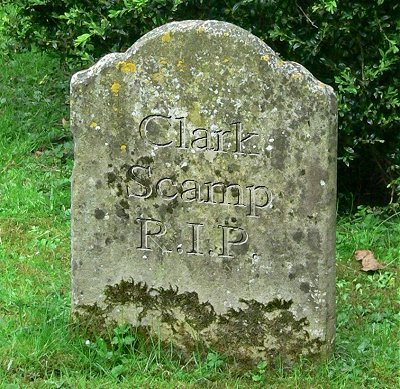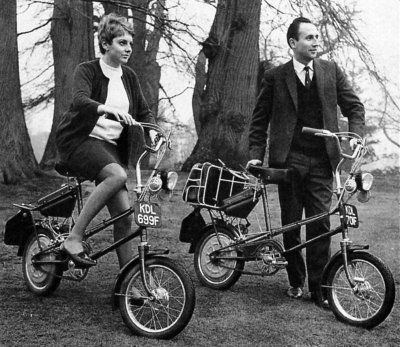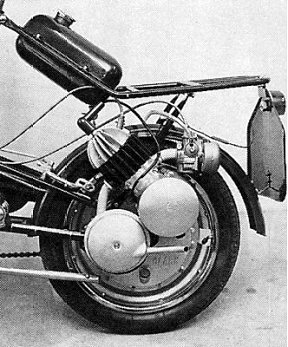


Drawn by a light in the sky, we continue
to follow the road south. Dusk beckons, and with it, again will
come the devils that have tormented us on our journey. We hurry
on as the sun sinks behind the woods of the New Forest, exploding the
autumn sky into a vivid paintbox of gilt. Towering high above the
trees and silhouetted against the embers of fading sunset, Judge
Peterson’s slender gothic needle at Sway points ominously to the
heavens of advancing night. Demonic yellow eyes start to glow in
the darkest patches of old dead stumps, as we run down the jetty at
Lymington to jump at the last second, onto the departing ferry.
The tolling of a church bell drifts across the water as land looms from
the mist, while our cloaked pilot in the prow raises an arm, and points
a bony finger—our destination, The Island of Vectis!
Pick up any motor cycle encyclopaedia you like, and strangely,
hardly anyone seems even to acknowledge the existence of this maker or
its machine! The Scamp was the rather unlikely product of ship’s
mast manufacturers A N Clark (Engineers) Ltd from the even
more unlikely location of Binstead, on the Isle of Wight! It’s
quite baffling how a maritime company decides to get involved in moped
manufacture, but the Scamp project was started in 1967 as a departure
from the usual yachting business. With no previous experience in
the field, that really is some wild diversification! Still, all
credit to Clark; they bravely committed themselves with an imaginative
and unique motor of their own design and manufacture, mounted in an
adaptation of the CWS ‘Commuter’ bicycle.

Glass’s Index lists:
‘Scamp’ 49.9cc
(2-stroke) 38mm bore × 44mm stroke, introduced March 1968 from engine
no. E10001, frame no. U10327. Scamp moped
introduced. Single speed, auto. clutch, rigid frame, brakes
front 3½" hub, rear calliper type, tyres 12"×2", ½ gal. tank, direct
lighting.
There is absolutely no ‘stock’ reference material available for the
Scamp, the only source on this machine coming from original literature,
club archives and records of enthusiasts’ contacts with the
manufacturer, so we really have to make the most from this information,
and study of surviving examples.
Our test feature machine today is engine number E11850, frame number
V12063, still in original condition and finished in red with gold
pinstripe. This bike is the highest frame serial so far recorded
by the register, and by contrast, also for the photoshoot, the second
blue bike displays engine no. 11955X, and the lowest recorded
frame serial: V10316.
Mounted on the left-hand side of the rear wheel, the conventional
piston-ported engine features radial finning on its alloy head and cast
iron cylinder. The crankshaft is most unusually constructed in
that the flywheels bolt together by socket cap screws, through the
big-end bearing core, with the con-rod seeming to run on uncaged roller
bearings, so the whole assembly would appear home serviceable with no
more than a simple Allen key! A Dansi flywheel magneto hangs off
the nearside journal, while the drive outputs to a simple single-stage
centrifugal clutch.
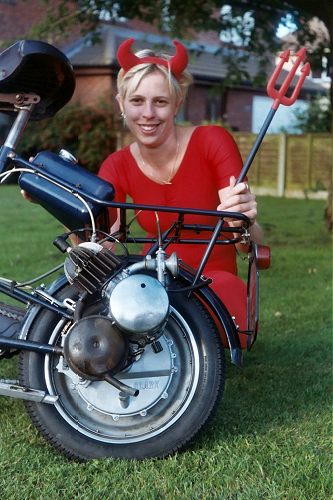
The rear ‘disc’ wheel is a primitive assembly comprising of a Dunlop
12"×2" rim crudely
bolted and riveted through the spoke holes to a pressed steel disc form
fixed to a driving flange. It may be little surprise to find such
wheels often display some buckle effects. The flange rotates on
bearings around the rear axle, driven on a shaft from a large reduction
gear running in an oil-bath alloy case, and powered by a pinion shaft
from the clutch drum. Turning a ‘power key’ located in the clutch
housing enables the drive to turn the motor by a counterbalanced nylon
pawl engaged through a slot in the clutch drum. Once the motor is
started, centrifugal force overcomes a spring to disengage the
pawl. The automatic clutch operates as motor revs are further
increased. Switching back the ‘power key’ disables the pawl as
the clutch rotates into contact, returning to bicycle function.
The feature bike’s motor is fed from an original fitment
12mm Amal 369/162 carburettor, though
the rider’s manual clearly illustrates a Dell’orto, so probably both
types could be fitted. The exhaust comprises two steel bowls
bolted together to form a chamber, and is easily stripped for
de-carbonising.
With its 12" wheels and 16"×2" tyres, the CWS ‘Commuter’ cycle borrows
much of its general impression from the RSW16 bicycle and Raleigh Wisp,
which pre-date the Clark by a couple of years. Adaptations to the
bicycle feature a hub front brake (though a calliper set is retained
for the rear), Radaelli saddle, specially wide rear rack mounting the
triangular petrol tank in its crook, fitment of a basic lighting set,
and suitable control equipment. The cycle propstand is woefully
inadequate for the bike as a moped, and any attempt to precariously
balance the machine on this flimsy leg is merely inviting the
inevitable. You might as well save time & trouble, and simply
throw the bike down on its engine side every time you park!
Leaning against walls or even backing the pedal against a kerbstone is
far less hazardous.
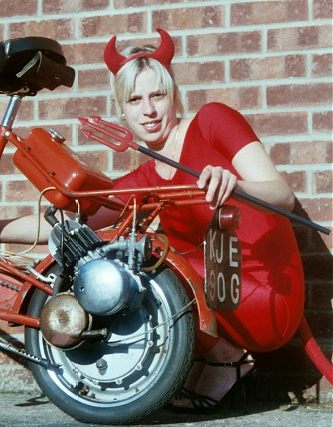
The lattice cycle chassis looks pretty impressive in its design and
structural construction, being the nearest interpretation imaginable of
a small-wheel version ‘Mixte’ frame, but anyone who’s ever ridden the
notoriously twitchy Raleigh Wisp is going to approach a Scamp with some
trepidation. It has much the same geometry as the Wisp, but with
the engine mounted at the rear wheel, the centre of gravity is going to
be further back—oh dear! Still, one has to remain optimistic!
Engage drive mode by pulling down the ‘power key’ and latch into
position by rotating it 90°. In drive mode, the Scamp can be
reversed easily on the freewheel, but moving forward will now turn the
engine, so needs the decompressor engaged to enable navigation.
Pull on the petrol tap at the fuel tank, and the choke is—a strangler
on the back of the carb down by the rear wheel! No linkage
control, no throttle latch; you can just bet this going to be
awkward! We pedal up the road on the decompressor, drop the
lever, and the drive disengages so we coast to stop with the drive pawl
clicking. The pawl doesn’t latch again until the bike stops
moving, to allow another starting attempt—with the same result.
During starting, it seems the pawl instantly disengages whenever the
engine stutters, and the trick is getting it to catch and run as soon
as the motor fires. This could take some time!
There is a primitive sort of tickle device on the carb, which
comprises the top of the float needle sticking through a hole in the
float chamber top. You can press this to flood the chamber,
though it doesn’t seem to offer any discernible advantage in the
starting procedure, and a veritable disadvantage would appear to be as
a direct access point to allow rainwater into the float chamber!


It takes several attempts before the engine does continue running,
but then you’ve got to stop and dismount to open the choke
shutter! To stop it stalling (since we don’t want to go through
the starting palaver again), the tendency is to keep it on the
throttle, but the automatic clutch drags and the bike tries to make off
down the road—so you have to hold on the front brake now, while you try
and open the strangler with your left hand down by the rear axle!
This proves hopeless if you’ve made the mistake of dismounting to the
left side, possible but awkward if you dismount to the right.
Once the choke shutter is actually open, it’s just as well to lift by
the rack to get the back wheel off the ground and rev it a bit on the
throttle to clear its throat. Now the engine starts to run slower
without dying out, we can remount and get underway.
A lot of these starting difficulties would certainly have frustrated
most customers, and it’s baffling as to why they ever sold machines
fitted with the Amal carb? The Dell’orto with its latch choke
mechanism would have been so much more suitable.
Anyway, back on the bike and off we go, open the throttle, and the
single-stage automatic clutch locks on in one bite at quite low revs,
so the Scamp really just chugs off the line. If you want
acceleration, then it’s going to have to come from your own leg
power! As we start to build towards cruising speed, one also
starts to become aware of the handling characteristics. Take a
hand off the bars to signal, and the Scamp feels as if it’s poised for
any opportunity to go chasing rabbits in the bushes! Just a
little more edgy than a Wisp, but the Ariel 3 is still number one
on the top 20 chart of ‘Bikes that are trying to kill you!’
Once the motor gets warmed up, Scamp cruises happily up to
25mph, above which vibrations start
coming in through the Radaelli seat and the ride becomes
uncomfortable. Hot engine, on the flat, with light tail wind, our
pace bike briefly glimpsed a very best of 30mph. Downhill, 34mph maximum—and that really wasn’t going to go
any faster! Speed falls away readily as the bike encounters any
incline, but it still manages to labour slowly up moderate hills at low
revs without the need to pedal, as the motor digs-in once it falls
below 20mph.
Both brakes prove suitably retarding when required, with even the
rear calliper function proving surprisingly effective, though small
wheel machines would typically be expected to deliver better hub
braking performance anyway, advantaged by the basic law of physics.
The flywheel magneto is a Dansi set, and the Clark rider’s manual
specifies lights of 15W front &
3W rear, but put in these wattage bulbs and
the dimness is unimaginable. More practical illumination is found
by reducing the ratings down to only 3W for
both front and rear, so perhaps the generator coil might be somewhat
down on output?

Scamp’s motor ran smoothly and evenly throughout the trial with
never any hint of four-stroking, a confidence inspiring little engine
that, once you’ve got it going, feels as if it’ll run as long and far
as you like. Getting started however is a most deterring
operation, and would obviously have proved unsuitable to many customers
for practical everyday transport. To make this situation even
worse, the plastic drive pawl developed a further reputation for rapid
failure! Clutch function also appears to engage prematurely and
makes slow running and acceleration operations un-conducive, while in
the longer term, all the working components of the clutch are cast from
zinc and very prone to complete disintegration. The rigid frame
and forks, in combination with the small wheels and vibration effects,
quickly prove fatiguing; then add these factors to the sedate
performance and spooky handling, and you’ve got a machine that the
rider probably isn’t going to enjoy for long.
Tragically, the Scamp never found time to evolve, since it came and
went in the same year! Glass’s Index lists the bike as
discontinued in November 1968. It was reported from Clark’s that
they ‘…could not compete with the Japanese and Continental companies
already established in the market. Due to continuing financial
difficulties a Receiver/Manager was appointed by Lloyds Bank resulting
in a 50% staff reduction at Binstead and a complete disposal of almost
all finished machines and components…’
Clearly a catastrophic conclusion, but why the situation occurred
isn’t really explained. With a selling price pitched at
46gns, the Scamp was appreciably cheaper
than its most obvious market competitor, the Raleigh Wisp at
57gnss, which was selling very well.
On the face of it, prospects for the Scamp might have looked pretty
good, but the ‘continuing financial difficulties’ element could suggest
that the company trading position might have been struggling for some
while. Reading between the lines that yachting work was failing
to support the company around this time, the Scamp project was embarked
upon as an alternative business generator. Though March might
have looked an ideal time to launch the bike to catch the start of the
sales season, Clarks seemed unaware of motor cycle marketing practice
of showing machines the previous November at Earls Court to ‘prime the
trade’ and initiate the advertising for advance orders. Trying to
find period magazine road tests or articles on the Scamp is practically
impossible, and Clark’s very own poster even fails to show a picture of
the bike!
What seems to have happened was that Clark found themselves still
sitting on a whole load of complete machines, cycles, engines and parts
at the end of the summer as a lack of advertising had failed to
generate sales. The season had passed, and a struggling company
was stuck with all the stock value—a classic formula for cash-flow
foreclosure. Big banks don’t tend to have much patience with
small companies trading in the red. Everything was flogged off
any way it could go, even chassis without engines were fitted with
standard cycle wheels at the back and simply cleared as bicycles.
Out on the streets, these could be readily spotted from the standard
CWS Commuter, by the dedicated Clark rear carrier with its big hole
where the petrol tank was intended to fit.
With a variation of the name, a new business rose from the ashes and
still trades today in Binstead on the Isle of Wight as Clark Masts
Teksam Ltd, and Clark Masts (Technical Services) Ltd. spare parts
company—but don’t expect them to supply any parts for your moped,
that’s all long gone.
No official figures are known of how many Scamps were actually made,
but the company suggested 3,000–4,000. With the frame series
seemingly starting from 10000, and considering our test machine is the
highest frame serial so far recorded by the club, a statistical
projection suggests the total is more likely to be within 2,500.
How many survive today? Who knows? However, it’s certainly
a lot more than some of the ridiculously low numbers being claimed in
most of the adverts by people trying to sell them!
Some say that God rides a Harley, well that may be a little
controversial—but if ‘Old Nick’ were to claim his own machine, who
knows? It might just be the Clark Scamp…
Next—The brief window of opportunity opens, to test another rare
autocycle as it passes between private collections. Such fleeting
chances come Out of the Blue, and there’s no
time to think—just grab the camera, notebook & pen, and go! The
dials of our time machine spin backward again, to another
adventure. A shattered Europe stumbles back to its feet, and it
is the old machines that will have to rebuild the new world. The
most economic motorised transport is particularly in demand, and sharp
commercial eyes spy an opportunity as Autocycles are emerging for their
second generation.

This article was produced with the
assistance of
Clark Masts Teksam
Ltd
This article appeared in the July 2007 Iceni CAM Magazine.
[Text & photographs © 2007 M Daniels. Montage ©
2007 A Pattle]
This will probably remain the most definitive reference article on the
Clark Scamp—so in making this little piece of history, we believe in
doing the best we can with the resources we have on the day, since it’s
pretty unlikely we’ll get the opportunity to visit it again—or so we
thought. However, one of the benefits of publishing on the Web is
the feedback we get and, in the case of The
Devil, one such e-mail has shed new light on the demise of the
Clark Scamp. So this is not the end of the story, the Devil will be riding out again later.
Speak of the Devil…
Dear Mark,
I was the first owner of Clark Scamp KJE 90G, which I bought
for £35 in 1968 from Allin’s cycle & autocycle dealer on Bridge Street
in Cambridge. I drove it home only to find that the front number
plate readd KJE 90G, so back to the shop for new transfers.
In those days you needed L-plates, but no crash helmet. Insurance
was 30 shillings per year (yes £1.50).
What a vile little machine! The cylinder head wobbled around,
making a lot of vibration. The engine connected to the bike frame
with a flat plate link. This fractured due to the vibration. The
rear light kept blowing due to vibration, so I hung the rear number
plate on leather straps. The centrifugal clutch wore out so I
riveted on leather ‘clutch plates’ instead. The advertised
200mpg was more like
20mpg when you opened the
throttle. I used to go to Marshall’s Garage on Jesus Lane for
petrol and a shot of Redex. Sediment always collected in the
neoprene fuel line.
I went back to Allin’s for a chat and they told me to chuck the
Scamp into the river. So much for after-sales service.
Wonder how many more Scamps are at the bottom of the Cam?
I never used the Power Key. It was only used if you wanted to
push the bike any distance by hand.
Method of starting the engine:
Tickle the Amal carburettor
Shut the carburettor intake disk
Open the decompresser using the handlebar lever
Stand to the left of the bike
Left hand on the throttle
Lift the rear wheel off the ground using the rear
carrier
Press down on the bike pedal to turn the engine
over
When the engine fired close the decompresser
Open the carb air intake disk
In 1969 I rode the Scamp from Cambridge to Peterborough, to catch a
train up North. The spark plug fouled up on the way to
Peterborough, so plug spanner in operation. Up North I got a rear
tyre puncture. Not possible to remove rear wheel, so puncture
repaired with bike lying on its side.
I then passed my driving test in Cambridge in a Ford Anglia 105E, so
off came the Scamp L-plates. I last used the Scamp in the early
1970s then gave it away. Just out of curiosity I Googled Clark
Scamp and saw my old bike on your website.
All the best from
Peter Dockerty.
[The old log book for KJE 90G lists just Peter
Dockerty as the first owner and Anthony Silvey next. The change
of ownership was never stamped and the bike wasn’t taxed after August
1971, so it looks as if Mr Silvey never got it to work well enough
to use.—Andrew]
This letter appeared in the April 2012 Iceni CAM Magazine.
Making The Devil
So what was it like producing
The Devil Rides Out? Difficult all the
way is the best answer. Taking several years in research and
generation, source material was the biggest problem, since so little
was available, and it was very hard to turn up much more than scraps of
anything new, so it mainly came down to collation, careful analysis of
what there was, and statistical projection. Once we’d finally got
the bike to work, the road test went well, and the main text on this
one came together fairly quickly—but the original ‘maritime’ intro
never felt right and didn’t let the story flow from the previous
link. So in the end, it got ripped right out, binned, and
completely reworked. The ‘demon journey’ was the final result,
travelling south and crossing the Solent to the Isle of Wight.
Vectis was of course, the old Roman name for the island, and it all
started tumbling into place like some antique Hammer horror.
The ‘little devil’ photoshoot had long been planned to match with
this article, way back years ago, when the project to produce the
feature first started. I guess the idea was inspired by the
original advertising poster. Scamp’s tiny wheels and low engine,
coupled with falling sun angle of early evening, meant practically all
pics had to be taken at low angle to avoid shadows—but not until
Rachael got kitted up, and framed in the viewfinder for the first shot,
with the sunlight flashing off that red leotard; only then you know it
really is going to work! With the shadows lengthening, the shoot
had to go quickly, with fast changes of set and location to follow the
light. Two rolls of film clicked through in 45 minutes, away
in the post to the developers on Monday 18th June, and a fast closing
deadline for Iceni2 at the end of the week. The film and discs
came back on Saturday 23rd, then straight on to Andrew for digital
additions. With the gothic arch and flames dropped into the lead
picture, final lay-up of the magazine could progress, and then there’s
all the printing to do! The timing certainly ran a bit tight on
this one, and it sure was a scramble to get everything completed for
Peninsularis, but we made it—just!
The Devil Rides Out hit a final bill of
£92 to complete the article, (film/developing/CDs £29, costume and
props £30, fuel £33), so you can see exactly where the money goes, and
all donations go directly towards production.

Devil’s Epitaph
2008 sees 40 years since the introduction of the Clark Scamp, and
the anniversary of our presentation on the machine.

While our previous article ‘The Devil Rides Out’
covers the Scamp in feature, following its publication last year
further researches have turned up fresh material and revelations have
bubbled to the surface as a result of our readers’ responses.

It seems that Clark was adopting its own original methods to market
the Scamp, employing sales rep, R T Townson, to travel the
country, making personal calls on motor cycle dealers to establish
agencies and secure orders. At this time, in the mid to late
’60s, there was an on-going government-initiated programme to promote
British goods and manufacturing—anyone remember the ‘I’m backing
Britain’ campaign? There are references by Townson that Clark had
also been following this theme to promote the Scamp.
Glass’s Index listed the Clark Scamp from March 1968.
Managing Director of Fretton’s of Coventry, and Chairman of the
National Association of Cycle & Motor Traders Committee, Reginald Reed,
produced a moped sales presentation to the Blackpool Council meeting of
21st March 1968, and previewing the forthcoming motor show at Belle
Vue, Manchester on 3rd April. This report included an outline of
the introduction of the Clark Scamp moped produced by Alec Clark from
Binstead, Isle of Wight, as an entirely new machine to be listed for
£48–6s–0d (46 Guineas), and being price-pitched as ‘the cheapest
machine of the year’. He went on to somewhat generously describe
‘The performance is lively [we wouldn’t!], maintenance remarkably easy,
though the ride is rather noisy and a little rough—but remember the
price—and it should find a ready market’. Then closing with the
statement that, ‘It may not be on view at Manchester, however’.
We came upon some interesting factory publicity pictures, showing
two early Scamps, both with Isle of Wight KDL series registrations that
reasonably date them to late 1967. The people in the photo are,
most likely, members of Staff at Clark: we have identified the man as
David Bennett, Clark’s Sales Director. The picture was probably
taken quite close to the factory although the area is now covered with
houses. A close-up picture is further interesting in that it
shows the engine fitted with a large Dell’orto carb, certainly the only
one we have actually seen. Although a few production machines had
the Dell’orto carb, the majority appeared with the Amal 369/162.
IceniCAM reader Paul Sugden relates that
the Scamp moped was the subject of a ‘Breach of Confidence’ case raised
in 1968 by a Mr Coco against A N Clark Engineering, for
manufacturing the moped engine from his drawings.
In 1965 Mr Coco began market research into the possibility of
producing a new moped, and proceeded to design one. By March 1967
a batch of pistons had been made for him in Italy and sent to him in
England. In April 1967 there was the first contact between
Mr Coco and A N Clark about the proposed moped and the
company expressed interest in making it. In a letter dated
24 April 1967 the company asked Coco to bring the prototype that
he had built to the works of the company. Over the next three
months there were many discussions between the parties and Coco
supplied Clark with information and drawings towards the production of
what had come to be known as ‘the Coco moped’. Clark did work on
Mr Coco’s ideas and also put forward draft documents concerning
the financial arrangements between them, but these documents were never
signed and terms were never agreed.
On 20 July 1967, A N Clark told Mr Coco that the
transmission of the Coco moped was creating a serious problem of
excessive wear to the rear tyre and that the company had decided to
abandon it and make its own moped to a different design. The Coco
moped used a roller-drive to the rear wheel. When the Scamp
appeared on the market, although it used a completely different
transmission, the engine was substantially similar to Mr Coco’s
design.
Mr Coco sued for breach of confidence in disclosure of his
drawings.
There was a preliminary hearing where Mr Coco applied for an
injunction to stop production of the Scamp as ‘interlocutory
relief’. The injunction was refused. Clarks undertook to
pay a royalty of 5/- (25p) for every Scamp engine manufactured into a
special joint bank account on trusts. The full trial would then
decide how much, if any, of the accumulated money would be awarded to
Mr Coco.
However, the trial never took place, the Scamp was discontinued, and
Clark went into administration.
Glass’s Index entry confirms production of the Scamp as ceased in
November 1968.
Despite not going to trial, the Coco v A N Clark
case established quite a legal landmark, and is still widely quoted in
legal cases as a test case example for breach of confidence.
It would certainly be of interest to add a reference copy of the
original Coco drawings to IceniCAM Information Service files, if anyone
might be able to turn up a print?
This epitaph could finally lay Scamp’s listless soul to rest, yet
still may not be the last word on this haunting spirit. Even as
this passage is typed, an ongoing engineering project could mean that
the little devil may return to grace these pages again someday—in some
rather unexpected form!
Further information
Clark documents in the On-line
Library:
Coco v Clark CH full text
Coco v Clark CH short text
Scamp accessories leaflet
Scamp adverts Trader 1967-12
Scamp adverts Trader 1968
Scamp article Trader 1968-02-23
Scamp article Trader 1968
Scamp clutch service sheet
Scamp instructions
Scamp leaflet
Scamp news Trader 1967-10-27
Scamp news Trader 1967-11-24
Scamp news Trader 1968-01-05
Scamp news Trader 1968-02-02
Scamp news Trader 1968-02-16
Scamp news Trader 1968-03-01
Scamp news Trader 1968-03-15
Scamp news Trader 1968-04-12
Scamp news Trader 1968-06-07
Scamp news Trader 1968-06-31
Scamp parts list
Scamp parts list update
Scamp parts price list
Scamp poster
Scamp Trader supplement
This article first appeared in the July 2008 Iceni CAM Magazine and
was later updated with more information on the Coco moped.
[Text © 2008, 2011 M Daniels & A Pattle.
Gravestone picture © 2008 A Pattle. Period pictures from IceniCAM Information Service]
Who was Mr Coco?
Information about the Mr Coco who
suggested a moped design to Clark is not easy to find … who was
he?
On 25 November 1948, The Motor Cycle
reported the arrival in Britain of three Italians who had ridden all
the way on Mini-Motors which, in the picture below, look as if they’re
mounted on very un-Italian Hercules bicycles. Their arrival was
planned to co-incide with that year’s Earls Court Motor Cycle Show and
thus to pubicise the launch of the Mini-Motor in Britain.
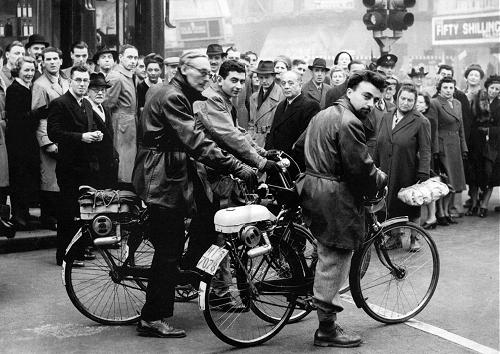
The three riders were: Vincenti Piatti (designer of the Mini-Motor),
Mario Coco (described as a technical illustrator), and C
Garbardi-Brocchi (a journalist). Is this the same Mr Coco?
More Devilry
IceniCAM readers may be aware of the
motor cycle drawings by Nick Ward that
regularly feature in Classic Bike
Guide. Co-incidentally, Nick’s drawing in the June 2008
edition of CBG featured a Clark Scamp.
Not just any Clark Scamp either, the model for the drawing was the blue
Scamp that was featured in our The Devil Rides Out
article.

© 2008 N Ward, all rights reserved
We are grateful to Nick for supplying us with a copy of his original
drawing and for granting us permission to reproduce it on this
website.
The Devil’s Disciples
Some of the people involved with the Clark Scamp

‘The Man Behind the Scamp’: founder of the company, Alec Clark.
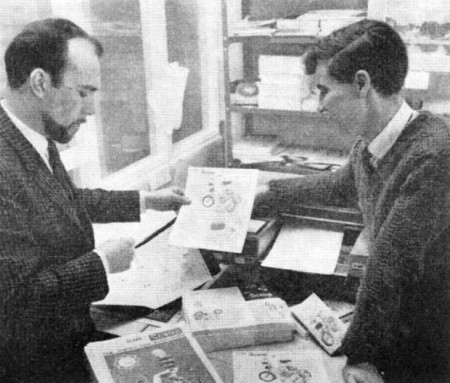
In the publicity Department: John Wright (left) and Vic Vine
(right).

Production Director Ken Phipps (left) and Machine-Shop Foreman John
Saunders (right). The equipment they are working with is a Wild
Barfield HF induction heater that was used for hrdening components
such as the drive pinion and con-rod.

Sales Manager: David Bennett.
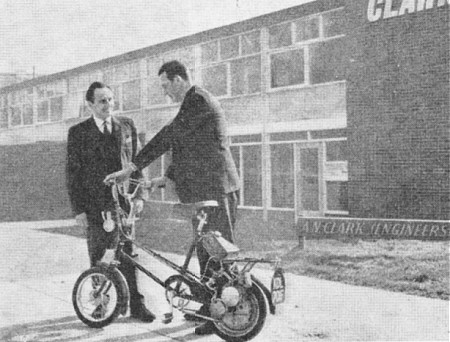
David Bennett & Ken Phipps outside the factory.
Making the Clark Scamp
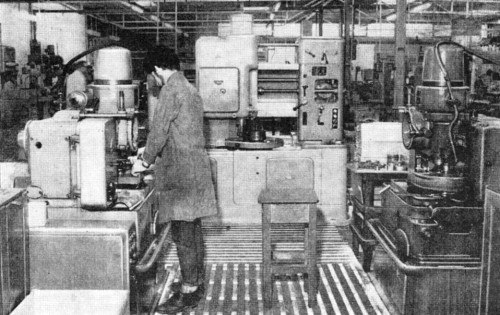
These three gear shaping machines were used to cut the teeth on the
drive pinion and the main gear.

An Avery metal hardness tester being used in the Quality Control
department to check the hardening of a rear wheel axle.

A crankshaft being machined on a Ward 3CA capstan lathe.

In pre-computer days, this peg-board was used in the Production
Control department to keep track of what was going on in the
factory.
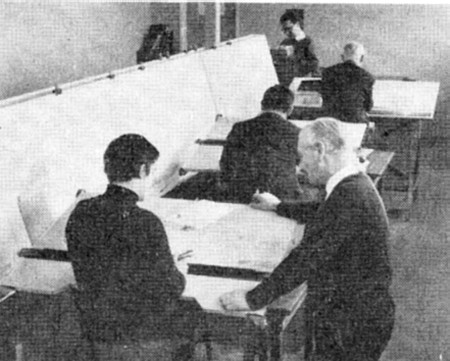
The Drawing Office.
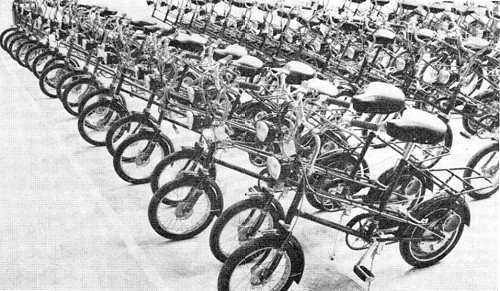
The first production batch of Scamps waiting to have their engines
fitted.

Road to Hell
The Coprolite Run in 2011 was witness
to an unprecedented Clark Scamp
flash mob! Among this demonic turnout were two Scamp motor
wheels on display in the hall and eight bikes, of which four were
green, three red, and one blue. Half the Scamps remained on
display, while two green, one red, and one blue were ridden at the
event. Our tale starts by following the exploits of these two
little green devils along the Coprolite course…
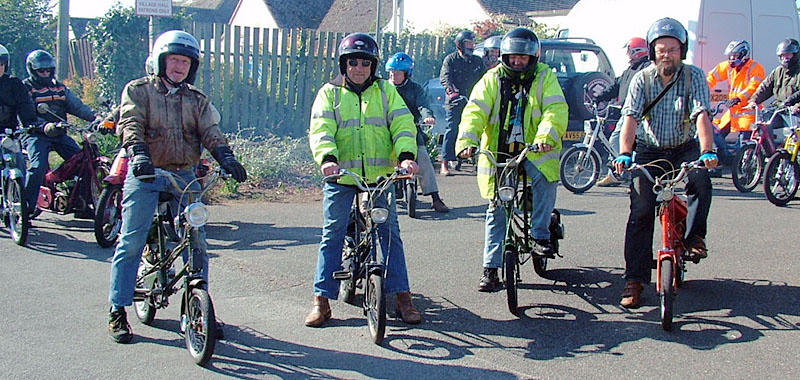
The four Scamp riders at the 2011 Coprolite Run. [Photo: Kell McLean]
It was an extraordinary moment to have four Scamps leading out the
run from the car park, then out along the route, though by the time
we were approaching the two-mile marker into Kirton, other bikes were
already starting to nudge ahead—Scamps it seems, may not be to
everyone’s taste … just because they’re slow?
By the time we were heading around Gulpher Road there seemed to be
more bikes pushing ahead and disappearing into the distance than
there were left behind—err, where is everybody?
Approaching the end of Gulpher Road, my ‘Green-1’ was seemingly
developing a bit of a rattling noise from the engine department, and
stopping for a check-up before the Golf Course revealed one of the
top-end studs had vibrated out of the crankcase, so continuing gently
for the last mile, I cruised in to the Ferry Boat Inn car park at
Felixstowe Ferry among the later arrivals. A quick spanner
check at this halfway stop re-tightened the stud ready for the return
leg, so Chris Day on ‘Green-2’, and Dave Watson on ‘Blue’ had arrived
before me, while Andrew Pattle on ‘Red’ became disabled with a rear
wheel puncture, which is a major fix on a Scamp, so ‘Red’ was down
and out.
The homeward trip on ‘Green-1’, V 10721 was more prudently
navigated along the direct route at low speed to minimise the effects
of further vibration-related issues, while Chris on ‘Green-2’ opted
for the full course at full speed.
Joining up again with the other two Scamps on the road back
towards Bucklesham, ‘Green-2’ U 11024 now had its front mudguard
strapped to the rear carrier, apparently having vibrated out all its
mounting bolts, until it fell down onto the wheel, and Chris had
subsequently ridden over it!
‘Blue’, ‘Green-1’, and ‘Green-2’ completed the course, but
vibration was certainly an issue.
The only way to reduce the vibrations was to ride slower…
Following the Coprolite Run, we performed further road tests and
photo-shoots on both green Scamps.
Road test ‘Green-1’, VBJ 116F, Frame number V 10721
(frame numbers started from 10000)
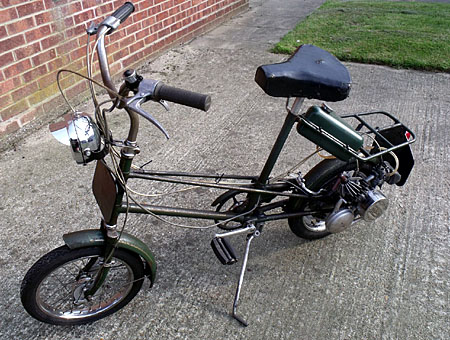
This bike is fitted with a Dell’orto SHA 14/12 carburettor,
whereas when we tested ‘Blue’ and ‘Red’ in the original Devil Rides
Out article back in July 2007, both those machines were fitted with
Amal 369/162 carburettors.
Starting is much easier with the Dell’orto carb, compared to the
Amal as fitted to other Scamp models. Click down the choke
lever at the carb, just in front of the air filter. Turn on
fuel under the right side of the tank.
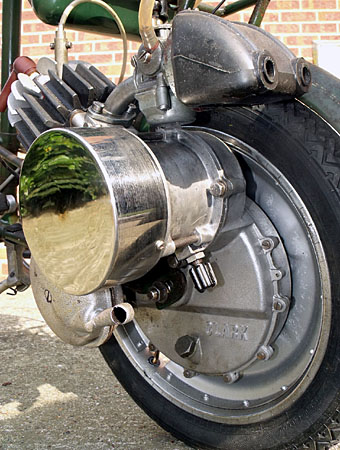
Switch the ‘power key’ (underneath the crankcase) into drive
position to engage the starting pawl. Hold in the decom-pressor
lever under the left handlebar cluster, then pedal off. This
requires a certain amount of physical effort to maintain, since the
decompressor venting doesn’t appear totally effective, but the engine
readily fires with a light tweak on the throttle and is soon coughing
against the choke, so open the throttle wide to automatically release
the strangler latch, and Scamp gasps in a few good cylinders-full of
air to clear its little lung.
Running quickly settles down to a crisp and mellow popping, with
little tweaks on the throttle being responded to with eager little
snatches on the automatic clutch. Scamp seems keen to go, so we
take off from the kerb. The automatic clutch bites fairly
readily, at which the high load and low revs situation makes Scamp’s
motor suddenly appreciate that pulling off is going to represent more
than it can manage without some assistance, so we help with a little
boost on the pedals to get through the initial movement phase.
Once away, the exhaust tone clears to a flat drone, with a hopeful
urge as Scamp gets stuck in to acquiring some pace. Describing
this as acceleration would probably be an optimistic term, as waves
of vibration flood in through the pedals from 10mph, increasing in frequency as the revs
creep up. It soon feels very much like you’re receiving an
electric shock through your feet!
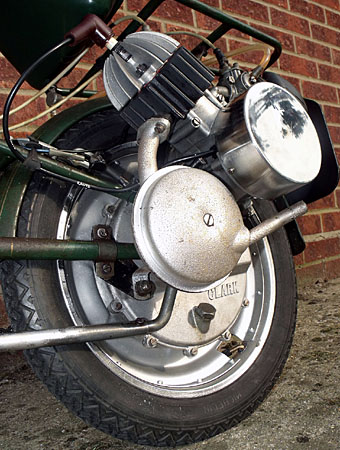
The bike seems to get through the worst of these vibrations by the
time its crawled a little past 20mph, so it proves better to settle for
general cruising between 22–23mph
(on pace bike tracking). Though this seems fairly close to
Scamp’s maximum on flat of 25mph,
it’s not actually thrashing the bike to death since the revs are
still relatively low, it’s just that the engine seems unable to pull
much more against its final drive ratio.
With no speedometer fitted, the pace bike tracked our downhill run
best at 34mph, but this
accumulated speed readily dropped away against the following uphill
gradient, right down to just 12mph, but ‘Green-1’ still doggedly crested the
rise without resorting to pedal assistance.
It has to be said that the vibration (probably due to poor crank
balance) was very tiring during our runs on this particular
Scamp. The only way to physically cope with our first couple of
‘impression’ runs of around 12 miles, was by riding the bike
slower. On the main test run after ‘holding off’ to warm the
engine for the first couple of miles, the remaining three to four
miles were ridden pretty much at full throttle. The vibration
on this main test run was particularly fatiguing, and made to seem
all the worse during the trial by constant cyclic drumming from the
reduction gear. These effects also take their toll on the cycle
parts as much as the rider. Vibration on the first ‘impression’
run managed to completely lose one crankcase screw and loosen a
second. Completing the main test run found the foot of our
side-stand had fallen out somewhere along the course! Readers
might be happy to know the pace bike retraced our tracks and found
the missing part in the road about a mile from base.
Though the rear calliper brake slowed down the bike adequately,
there was a number of complaining groans registered from the
straining brake blocks. The front drum brake proved more
effective and less stressed in operation, but you generally wouldn’t
want to rely on that alone. A considered balance of the two
brakes was certainly the best formula.
The original fitment Radaelli sprung mattress saddle is never
going to be any contender in the sumptuous comfort competition,
though it proved generally adequate for the more commonly short
distances at the typical low speeds that the average Scamp rider
might care to normally suffer the bike for. When running at
higher speeds, the vibration and constant road battering from the
suspension-less frame will come right through and scramble the
rider.
It appears that not all Scamps were born equal. The variable
quality of Clark’s machining and pot-luck crank balance could
seemingly result in a number of shades of grey!
The lighting arrangement on this bike was converted to 15/15W
beam/dip equipment with 3W tail, and the Dansi generator produced
good light from both lamps, perfectly adequate for the bike at night
considering the limited performance of the machine. The Miller
horn also produced an effective and easily audible tone.
It’s not very often we get to compliment effective electrics on
old bikes we try—shame about the rest of the Scamp...
Road test ‘Green-2’, XDY 855H, Frame number U 11024
with Amal 369/162 carburettor.
The remarkable thing about this machine is it’s the only example
we’ve seen fitted with a Huret speedometer set and marked as a 16×1.2
ratio Huret drive. This was apparently listed as a genuine
Clark accessory kit, and we’ve never seen a Huret drive like this
ever before. There’s obviously no question that this special
Huret kit existed to specifically suit the 12/16” wheel size, but we
can only wonder why Raleigh never offered the set for the Wisp?


As a reminder how much ‘fun’ it is starting a Scamp with the Amal
carburettor…

Pull on the petrol tap at the fuel tank, and the choke is … a
strangler on the back of the carb down by the rear wheel! No
linkage control, and no throttle latch to release it; you can just
bet this going to be awkward! There is a primitive sort of
tickle device on the carb, which comprises the top of the float
needle sticking through a hole in the float chamber top. You
can press this to flood the chamber, though it doesn’t seem to offer
any discernible advantage in the starting procedure, and a veritable
disadvantage would appear to be as a direct access point to allow
rainwater into the float chamber!
It takes several attempts before the engine does continue running,
but then you’ve got to stop and dismount to open the choke
shutter! To stop it stalling (since we don’t want to go through
the starting palaver again), the tendency is to keep it on the
throttle, but the automatic clutch drags and the bike tries to make
off down the road, so you have to hold on the front brake now, while
you try and open the strangler with your left hand down by the rear
axle! This proves hopeless if you’ve made the mistake of
dismounting to the left side, possible but awkward if you dismount to
the right. Once the choke shutter is actually open, it’s just
as well to lift by the rack to get the back wheel off the ground and
rev it a bit on the throttle to clear its throat. Now the
engine starts to run slower without dying out, so you can remount and
finally get underway.
A lot of these starting difficulties would certainly have
frustrated most customers, and it’s baffling as to why they ever sold
machines fitted with the Amal carb?

Since Huret speedometers can never be trusted to deliver accurate
readings, the road test on ‘Green-2’ was accompanied by our pace
bike. Best on flat with tailwind paced 29mph (speedo bouncing between 32–35), downhill
paced 35mph (speedo very
ambitiously pinned around 40mph
on the end stop), and the following uphill climb slowed to
14mph before cresting the rise on
engine power alone (without any pedal assistance).
The Huret speedo presented fairly accurate indications up to 25 on
the clock, above which the needle began to swing increasingly wildly,
and became more optimistic in its indications, which were generally
taken as an average on the swingometer. There seemed fewer
vibration issues with ‘Green-2’, and less rider impression of cyclic
drumming than ‘Green-1’. There was also noticeably less transmission
noise commented on by our pace rider, who was mostly following on the
offside rear quarter.
Since our original Scamp articles: Devil Rides Out in July 2007,
and its follow up Devil’s Epitaph in July 2008, we’ve added a number
more items to the IceniCAM information service, including the full
Coco v A.N.Clark Chancery Division 13-page legal account details (or
five-page summary if you want the short version). It’s
certainly an interesting read, whether you agree with the final
outcome or not. From a technical point of view, Clark’s point
regarding the wear rate of CoCo’s roller drive to the small 16-inch
tyre was certainly very justified—drive roller induced wear would
have been diabolical on a 16-inch tyre diameter. Also much
focus of the outcome of the case was based on specific aspects of the
engine design, which (from an engineering point of view) seemed to
have (questionably) played against Clark, since just about every
variation the basic piston-ported two-stroke engine design had
already been made by just about everybody, and there was nothing
special about a bought-in proprietary two-stroke piston.
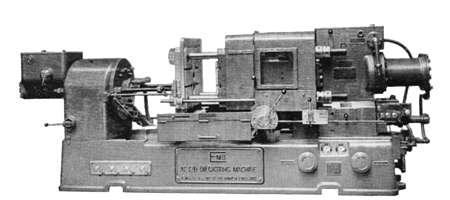
An EMB 12B Cold Chamber Diecaster—
as used for casting Scamp crankcases.
The legal action didn’t change the reality that the engine was
pretty dreadful. From an engineering aspect, the pinion design
to the ring gear required a difficult standard of machining precision
(that ANC obviously couldn’t achieve), to prevent the cyclic drumming
and vibration issues. Quality issues with crankcases full of
voids, suggesting the die-cast machines were not gas-boosted for the
initial charge phase, and just relying on a slower hydraulic
delivery. Further, the tooling was possibly not equipped with
suitable overflows to effectively vent the die, resulting in porous
castings, which allowed the crankcase studs to pull out since they
had insufficient material to anchor the threads. The zinc cast
clutch components, and starter pawl were all too frail and
consistently failed, and we could go on, but you get the drift, so
what’s the point?
Another interesting info file is the Scamp Accessories Leaflet,
which lists and illustrates the speedo kit, but instead of the
French-made Huret set, it shows a Dutch-made Lucia set!
The period advertising files are hysterical, ‘designed for women’
… ‘err, might that maybe put men off from buying it?’ …. OK, we’ll do
a different ‘man’s’ advert too! Period marketing, no idea…
There are now 25 historical and fascinating Scamp related archive files in our IceniCAM Info
Service, all as free PDF downloads.
Next—If everything goes according to plan, then we might hopefully
be having a Derbi Day, but I
wouldn’t bet on it!
This article appeared in the April 2023 Iceni CAM Magazine.
[Text & photographs © 2023 M Daniels.
Making Road to Hell
Since the famous Clark Scamp flash mob
was at the Coprolite Run in 2011, we could say this article has been
twelve years in the making—but you may ask why we didn’t produce it
sooner?
Following the Coprolite Run, some of the Scamps were displayed on
the EACC stand at Copdock Show in 2011, then Green-1 & Green-2 were
formally road tested and photo-shot in September and October 2011,
before both bikes were subsequently sold on. In the meantime a
further Scamp project was underway to adapt a Watsonian cycle sidecar
chassis to mount a Scamp motorwheel as a ‘pusher wheel’ that could be
attached to a bicycle.
Mopedland completed all the metalwork to adapt and fit the Scamp
rear wheel to the sidecar chassis, with an Atco lawnmower fuel supply
tank mounted above the wheel, and mudguard brackets. All the
technical mechanics were sorted, and returned to the customer for
finishing final assembly and fitting for operation. This Scamp
‘pusher wheel’ cycle was subsequently supposed to come back to us for a
feature and to complete the planned article, but the trail grew
cold. We presume the Scamp pusher wheel kit is still out there
somewhere, and may turn up again some day … but after 12 years we
finally gave up on the prospect of the intended article, and decided on
this rewrite to clear the decks.











